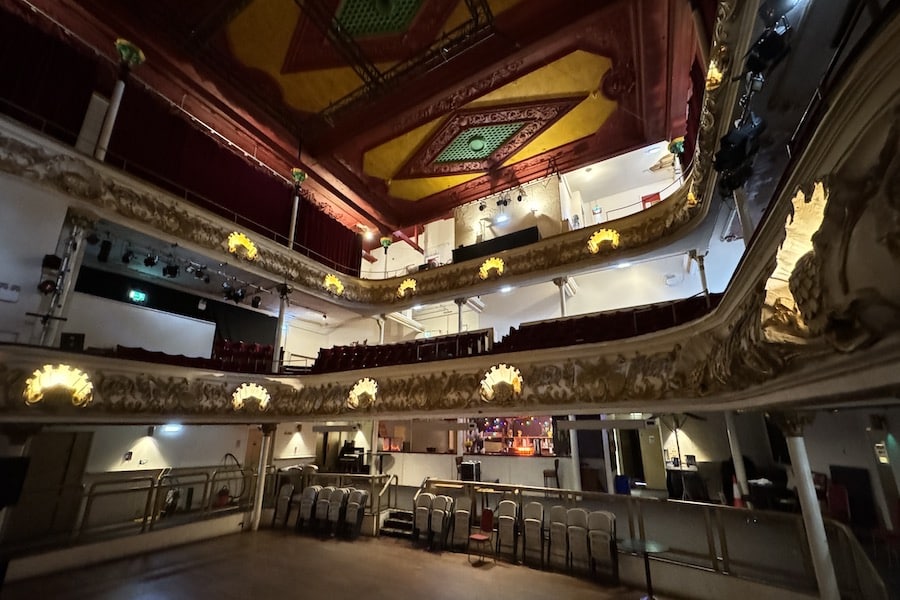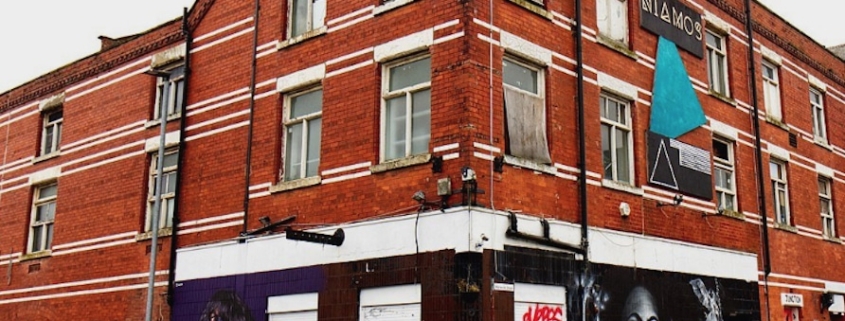THE NIAMOS CENTRE
THE NIAMOS CENTRE
hosted The Beatles & Nina Simone
and you can help this venue says Norman Warwick

Nestled in the vibrant neighbourhood of Hulme, The Niamos Centre celebrates the rich cultural history and community spirit of The Manchester hinterland.
This historic venue has seen numerous transformations since its opening in 1902.
The interior, though, is anything but ordinary.
Filled inside with beautiful Art Nouveau and Edwardian features (including gorgeous seashell light fixtures, rich velvet seats, incredible stucco renderings, and a beautifully vibrant roof), will surely reward your interest with fascinating sights.
Although maybe it has seen its best years, it still has potential.
Dave Whiting (left), a Director of the Niamos Centre, has recently discussed what the place was once all about and how its former glory might be restored.
He describes the Niamos Centre, as a space that: “not only hosts a variety of classes and cultural events but also stands as a pillar of support for the local community.”
Dave explains that the venue features a wide array of programs, from music and comedy gigs to yoga and dance classes.
Most recently, the Centre was bustling with energy as the BBC filmed a segment with Mr. Tumble, or “Mr Tumble’s replacement”.
The day before, it had hosted the Green Island Festival in collaboration with the local Garden Centre, which was packed to the rafters.
So it’s an important venue for the area.
They’ve also hosted white-collar boxing, stand-up comedy, you name it – it all happens at The Niamos Centre.
Despite its success in attracting events, the Niamos Centre faces significant financial challenges.
It’s an old and very beautiful building, with an ailing roof, and many other issues as you’d expect with a building built in 1902.

But its beauty, and importance to the Hulme community cannot be denied.
That it’s a vital artery of culture that should be supported, became evident as Dave discussed the socio-economic shifts in Hulme, noting that while the area has experienced some degree of gentrification, Niamos remains committed to serving ‘marginalised and impoverished people.’
He said: “The history of this place is something we’re striving to maintain. Built in 1902, the building was designed to blend in with the surrounding factories, creating a welcoming environment for the working-class community.
The intention was to ensure that the local, often poor, residents felt comfortable and that the building didn’t stand out.

Dave continued: ´Hulme has historically been an area with a high level of poverty, traditionally known for its slums. Over time, we’ve seen some improvements as gentrification has started to take hold. As Hulme continues to evolve, our goal is to ensure that the remaining members of the community, particularly those who are marginalised and impoverished, continue to benefit from The Niamos Centre. We want to build on the changes to support and uplift these individuals.
Touring shows would end their tours here, offering performances at reduced rates for those who couldn’t afford higher-priced tickets elsewhere. Back then, they managed to accommodate around 1,200 people by cramming them side by side in wooden seats.
While we can’t replicate those exact conditions due to modern insurance and safety regulations, our goal remains to keep the venue accessible for community use.
We aim to empower the community, provide jobs, and offer various classes and entertainment options. Currently, we are working tirelessly to secure the necessary funds to achieve this vision.”
The theatre boasts a rich history, having hosted legends like Nina Simone, Laurel and Hardy, and the first radio broadcast of The Beatles.
During the 1990s, it became a hotspot for reggae artists, amplifying its cultural significance.
However, Dave said that the cost of living crisis, and constant financial strains are taking their toll.
For instance, the Centre pays a hefty £4,000 per month to a private landlord, alongside astronomical electric bills.
Maintaining a historic building comes with significant financial challenges.
“We’re understaffed and overcharged… our landlord is charging us four grand a month. It’s outrageous really”, added Dave.
High electricity costs have also been a burden, but efforts are being made to reduce expenses with more efficient lighting.
“We’ve done something about it. These shells are all LED now.”
Despite these hurdles, the Niamos Centre continues to push forward, aiming to eventually provide jobs and more support for community programs.
The Niamos Centre thrives on community support. so there are ways in which The Nimos Theatre community and like-minded arts lovers could help.
Donations and volunteer efforts are crucial to maintaining and expanding its programs.
By supporting the Niamos Centre, whether through donations or active participation, you contribute to a legacy of creativity, community, and cultural richness.
You can donate to the Niamos Centre by checking the I love Manchester site on line and you can find out all of the awesome events taking place at The Niamos Centre by checking out their listings at the same site.
Your contribution could help sustain the legacy of The History of the Niamos Centre. This NIA Centre, is run by Niamos, and is a historic theatre and would be sorely missed in the heart of Hulme.
It’s one of the oldest theatres in Manchester! Furthermore, it is also one of the last two standing W.H. Broadhead theatres still in use.
Broadhead championed accessibility in the arts and designed the building to resemble a factory from the outside.
In its early years, the Niamos Centre (then Hulme Hippodrome) quickly became the centre of the community.
However, by 1929, the building was converted into a cinema and renamed the Junction Picture Theatre, reflecting the changing entertainment preferences of the era.
This transition marked the first of many significant evolutions for the venue. In 1950, the building returned to its theatrical roots and was renamed The Playhouse. The first performance in the newly converted theatre was “The Happiest Days of Your Life,” a farce that had recently been adapted into a film, debuting on January 22, 1951.
This period ushered in a new wave of theatrical productions, drawing audiences back to live performances.
The Playhouse’s prominence continued to grow when the BBC purchased the theatre in 1956. It became a bustling production venue for radio and television shows. The first broadcast from the BBC’s new acquisition was a televised revue entitled Call It A Day.
Over the next three decades, the theatre hosted numerous iconic productions, including that Beatles’ radio debut on March 7, 1962. The Fab Four performed memorable covers of Dream Baby (How Long Must I Dream?), Memphis, Tennessee, and Please Mister Postman in front of a live studio audience.
The last BBC production in the theatre took place on 25 August 1986.
With funding provided by Manchester City Council and other groups, the building was subsequently bought and converted into an arts centre, The NIA Centre, now the NIAMOS we know today.
Sidetracks & Detours learned about these ambitions for the venue when this article was first published on 20 June 2024 by the always uplifting and informative I Love Manchester Newsletter. You can subscribe to the newsletter to benefit from updates on this project from time to time.




Leave a Reply
Want to join the discussion?Feel free to contribute!